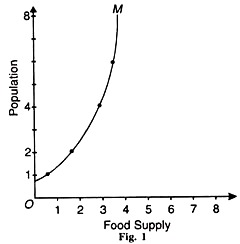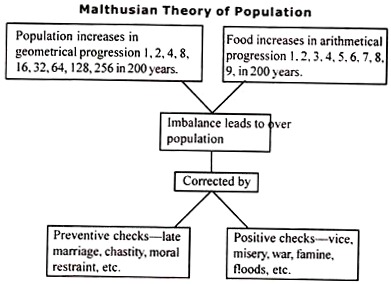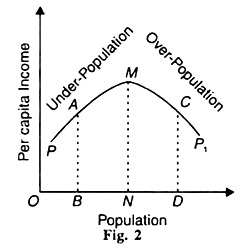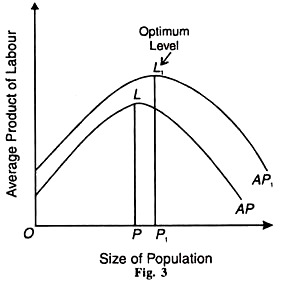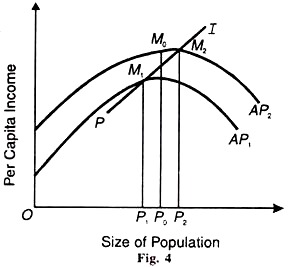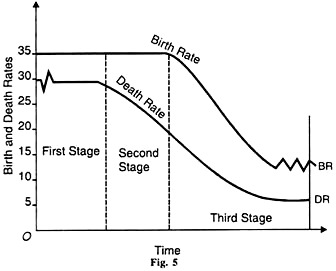The following points highlight the top three theories of population. The theories are: 1. The Malthusian Theory of Population 2. The Optimum Theory of Population 3. The Theory of Demographic Transition.
Population: Theory # 1. The Malthusian Theory of Population:
Thomas Robert Malthus enunciated his views about population in his famous book, Essay on the Principle of Population as it affects the Future Improvement of Society, published in 1798. Malthus revolted against the prevailing optimism shared by his father and Godwin that a perfect state could be attained if human restraints could be removed.
Malthus objection was that the pressure of increasing population on the food supply would destroy perfection and there would be misery in the world. Malthus was severely criticised for his pessimistic views which led him to travel on the continent of Europe to gather data in support of his thesis.
He incorporated his researches in the second edition of his Essay published in 1803. The Malthusian theory explains the relationship between the growth in food supply and in population. It states that population increases faster than food supply and if unchecked leads to vice or misery.
ADVERTISEMENTS:
The Malthusian doctrine is stated as follows:
(1) There is a natural sex instinct in human beings to increase at a fast rate. As a result, population increases in geometrical progression and if unchecked doubles itself every 25 years. Thus starting from 1, population in successive periods of 25 years will be 1, 2, 4, 8, 16, 32, 64, 128, 256 (after 200 years).
(2) On the other hand, the food supply increases in a slow arithmetical progression due to the operation of the law of diminishing returns based on the supposition that the supply of land is constant. Thus the food supply in successive similar periods will be 1, 2, 3, 4, 5, 6, 7, 8, and 9 (after 200 years).
(3) Since population increases in geometrical progression and the food supply in arithmetical progression, population tends to outrun food supply. Thus an imbalance is created which leads to over-population. This is depicted in Figure 1.
The food supply in arithmetical progression is measured on the horizontal axis and the population in geometrical progression on the vertical axis. The curve M is the Malthusian population curve which shows the relation between population growth and increase in food supply. It rises upward swiftly.
(4) To control over-population resulting from the imbalance between population and food supply, Malthus suggested preventive checks and positive checks. The preventive checks are applied by a man to control the birth rate. They are foresight, late marriage, celibacy, moral restraint, etc.
If people fail to check growth of population by the adoption of preventive checks, positive checks operate in the form of vice, misery, famine, war, disease, pestilence, floods and other natural calamities which
tend to reduce population and thereby bring a balance with food supply.
According to Malthus, preventive checks are always in operation in a civilized society, for positive checks are crude. Malthus appealed to his countrymen to adopt preventive checks in order to avoid vice or misery resulting from the positive checks.
ADVERTISEMENTS:
Malthus doctrine is illustrated below.
Criticisms of the Malthusian Doctrine:
The Malthusian theory of population has been widely discussed and criticised during the 19th and early 20th century.
Some of the criticisms are as follows:
(1) Mathematical Form of the Theory Wrong:
The mathematical formulation of Malthus’ doctrine that food supply increases in arithmetical progression and population increases in geometrical progression in 25 years have not been proved empirically. Rather, the food supply has increased more than in the arithmetical progression while population growth has not been in geometrical progression so as to double the population in 25 years. But this criticism is beside the point because Malthus used his mathematical formulation to make his principle clear in the first edition of his Essay and deleted it in its second edition.
(2) Failed to foresee the Opening up of New Areas:
Malthus had a narrow vision and was particularly influenced by local conditions in England. He failed to foresee the opening up of new areas of Australia, the United States and Argentina where extensive farming of virgin lands led to increased production of food.
As a result, countries like England on the continent of Europe have been provided with abundant supplies of cheap food. This has been made possible with rapid improvements in the means of transport, a factor almost overlooked by Malthus. No country need fear starvation and misery if it does not produce sufficient for its increasing population these days.
ADVERTISEMENTS:
(3) Applied a Static Economic Law to a Period of Time:
The Malthusian notion that the food supply increases in arithmetical progression is based on a static economic law at any one time, i.e. the law of diminishing returns. Malthus could not foresee the unprecedented increase in scientific knowledge and agricultural inventions over a period of time which has stayed the law of diminishing returns. Consequently, the food supply has increased much faster than in arithmetical progression. Malthus has been proved wrong not only in the advanced countries but also in developing countries like India with the ‘green revolution’.
(4) Neglected the Manpower Aspect in Population:
One of the principal weaknesses of Malthus’ thought has been that he neglected the manpower aspect in population growth. He was a pessimist and dreaded every increase in population. He forgot, according to Cannan, that “a baby comes to the world not only with a mouth and a stomach, but also with a pair of hands.”
ADVERTISEMENTS:
This implies that an increase in population means an increase in manpower which may tend to increase not only agricultural but also industrial production and thus makes the country rich by an equitable distribution of wealth and income. As rightly pointed out by Seligman “The problem of population is not merely one of mere size but of efficient production and equitable distribution.” Thus the increase in population may be necessary.
(5) Population not related to Food Supply but to Total Wealth:
The Malthusian theory rests on a weak relationship between population and food supply. In fact, the right relationship is between population and total wealth of the country. This is the basis of the optimum theory of population. The argument is that if a country is rich materially and even if it does not produce enough food for its population, it can feed the people well by importing food stuffs in exchange for its products or money.
The classic example is of Great Britain which imports almost all its food requirements from Holland, Denmark, Belgium and Argentina because it concentrates more on the production of wealth rather than on food products. Thus the very basis of the Malthusian doctrine has been proved wrong.
ADVERTISEMENTS:
(6) Increase in Population the Result of declining Death Rate:
The Malthusian theory is one sided. It takes the increase in population as the result of a rising birth rate, whereas population has grown considerably the world over due to a decline in death rate. Malthus could not foresee the marvellous advancements in the field of medical sciences which have controlled fatal diseases and made human life longer. This has been particularly so in underdeveloped countries like India where the Malthusian theory is said operate.
(7) Empirical Evidence proves this Theory Wrong:
Empirically, it has been proved by demographists that population growth is a function of the level of per capita income. When per capita income increases rapidly, it lowers the fertility rate and the rate of population growth declines. Dumont’s “social capillarity thesis” has proved that with the increase in per capita incomes, the desire to have more children to supplement parental incomes declines.
When people are accustomed to a high standard of living, it becomes a costly affair to rear a large family. Population tends to become stationary because people refuse to lower their standard of living. This has actually happened in the case of Japan, France and other western countries.
(8) Preventive Checks do not pertain to Moral Restraint:
ADVERTISEMENTS:
Malthus was essentially a religious man who laid emphasis on moral restraint, celibacy, late marriage, etc. to control population. But he could not visualize that human beings would invent contraceptives and other family planning devices for birth control. This was perhaps due to the fact that he could not make any distinction between sexual desire and the desire to have children.
People have sexual desire but they do not want to have more children. Thus moral restraint alone cannot help to control the increase in population which Malthus suggested. Family Planning is essential as a preventive check.
(9) Positive Checks not due to Over-population:
Malthus’ pessimism and religious education led him to believe that over-population was a heavy burden on the earth which was automatically lessened by God in the form of misery, wars, famines, floods, diseases, pestilence, etc. But all these are natural calamities which are not peculiar to over-populated countries. They visit even those countries where the population is on the decline or stationary, such as France and Japan.
(10) Malthus a False Prophet:
The Malthusian theory is not applicable to countries for which this was propounded. In the western European countries, the bogey and pessimism of Malthus has been overcome. His prophecy that misery will stalk these countries if they fail to check the growth of population through preventive checks has been proved wrong by a decline in birth rate, adequacy of food supply, and increase in agricultural and industrial production. Thus Malthus has proved to be a false prophet.
Its Applicability:
ADVERTISEMENTS:
Despite these weaknesses, the Malthusian doctrine contains much truth. The Malthusian doctrine may not be applicable to the Western Europe and England but its principal tools have become the part and parcel of the people of these countries. If these lands do not face the problems of over-population and misery, it is all due to the bogey and pessimism of Malthusianism.
In fact, the people of Europe were made wiser by Malthus who forewarned them of the evils of over-population and they started adopting measurers toward it off. The very fact that people use preventive checks, like late marriage and various contraceptives and birth control measures on an extensive scale proves the vitality of the Malthusian law.
Even famous economists like Marshall and Pigou and sociologists like Darwin were influenced by this principle when they incorporated it in their theories. And Keynes, initially overawed by the Malthusian fears of over-population, later wrote about “Some Economic Consequences of Declining Population.” Is it not the fear of Malthusianism which has created the problem of declining population in France?
The Malthusian doctrine may not be applicable now to its place of origin, but its influence spreads over two-third of this universe. Excluding Japan, the whole of Asia, Africa and South America come under its purview. India is one of the first countries to adopt family planning on state level to control population. Positive checks like floods, wars, droughts, diseases, etc. operate. The birth and death rates are high. The growth rate of population is about 2 per cent per annum.
The real aim of population policy is, however, not to avoid starvation but to eliminate poverty so as to raise output per head in an accelerated manner. Thus the Malthusian theory is fully applicable to underdeveloped countries like India. Walker was right when he wrote: “The Malthusian theory is applicable to all communities without any consideration of colour and place. Malthusianism has stood un-shattered, impregnable amid all the controversy that has raged around it.”
Population: Theory # 2. The Optimum Theory of Population:
The optimum theory of population was propounded by Edwin Cannan in his book Wealth published in 1924 and popularized by Robbins, Dalton and Carr-Saunders. Unlike the Malthusian theory, the optimum theory does not establish relationship between population growth and food supply. Rather, it is concerned with the relation between the size of population and production of wealth.
ADVERTISEMENTS:
The Malthusian theory is a general theory which studies the population problem of a country in keeping with its economic conditions. Thus the optimum theory is more realistic than the Malthusian theory of population.
Definitions:
But what is optimum population? The optimum population is the ideal population which combined with the other available resources or means of production of the country will yield the maximum returns or income per head.
The concept of optimum population has been defined differently by Robbins, Carr- Saunders and Dalton. Robbins defines it as “the population which just makes the maximum returns possible is the optimum population or the best possible population.” Carr-Saunders defines it as “that population which produces maximum economic welfare”. To Dalton, “Optimum population is that which gives the maximum income per head.” If we were to examine these views, we find that Dalton’s view is more scientific and realistic which we follow.
Assumptions:
This theory is based on the following assumptions:
1. The natural resources of a country are given at a point of time but they change over time.
2. There is no change in techniques of production.
ADVERTISEMENTS:
3. The stock of capital remains constant.
4. The habits and tastes of the people do not change.
5. The ratio of working population to total population remains constant even with the growth of population.
6. Working hours of labour do not change.
7. Modes of business organisation are constant.
The Theory:
Given these assumptions, the optimum population is that ideal size of population which provides the maximum income per head. Any rise or diminution in the size of the population above or below the optimum level will diminish income per head.
Given the stock of natural resources, the technique of production and the stock of capital in a country, there is a definite size of population corresponding to the highest per capita income. Other things being equal, any deviation from this optimum-sized population will lead to a reduction in the per capita income.
If the increase in population is followed by the increase in per capita income, the country is under-populated and it can afford to increase its population till it reaches the optimum level. On the contrary, if the increase in population leads to diminution in per capita income, the country is over- populated and needs a decline in population till the per capita income is maximised. This is illustrated in Figure 2.
In the figure, OB population is measured along the horizontal axis and per capita income on the vertical axis. In the beginning, there is under-population and per capita income increases with population growth. The per capita income is BA population which is less than the maximum per capita income level NM. The ON size of population represents the optimum level where per capita income NM is the maximum.
If there is a continuous increase in population from ON to OD then the law of diminishing returns applies to production. As a result, the per capita production is lowered and the per capita income also declines to DC due to increase in population. Thus ND represents over-population. This is the static version of the theory. But the optimum level is not a fixed point.
It changes with a change in any of the factors assumed to be given. For instance, if there are improvements in the methods and techniques of production, the output per head will rise and the optimum point will shift upward.
What the optimum point for the country is today, may not be tomorrow if the stock of natural resources increases and the optimum point will be higher than before. Thus the optimum is not a fixed but a movable point.
According to Cannan, “At any given time, increase of labour up to a certain point is attended by increasing proportionate returns and beyond that point further increase of о labour is attended by diminishing proportionate returns.” The per capita income is the highest at the point where the average product of labour starts falling. This point of maximum returns is the point of optimum population.
This is illustrated in Figure3. The size of population is measured on the horizontal axis 2 and the average product of labour on the vertical axis. AP is the average product of labour or income per head curve. Up to OP level, increases in population lead to a rise in the average product of labour and per capita income.
Beyond OP, the average product of labour and per capita income falls. Hence when population is OP, the per capita income is the highest at point L. Thus, OP is the optimum level of population. To the left of OP, the country is under-populated and beyond OP, it is over-populated.
However, OP is not a fixed point. If due to inventions there are improvements in the techniques of production, the average product of labour might increase and push the level of per capita income upward so that the optimum point rises. This is shown in the figure where the AP1 curve represents the higher average product of labour and point L shows the maximum per capita income at the new optimum level of population OP1.
Dalton’s Formula:
Dalton has deduced over-population and under-population which result in the deviation from the optimum level of population in the form of a formula. The deviation from the optimum, he calls maladjustment. Maladjustment (M) is a function of two variables, the optimum level of population О and the actual level of population A.
The maladjustment is M = A-0/0
When M is positive, the country is over-populated, and if it is negative, the country is under-populated. When M is zero, the country possesses optimum population. Since it is not possible to measure O, this formula is only of academic interest.
Its Superiority Over the Malthusian Theory:
The optimum theory of population is superior to the Malthusian theory on the following grounds:
(1) The Malthusian law is a general study of the population problem because it is applicable to all countries irrespective of their economic conditions. The optimum theory is superior to the Malthusian theory because it studies the population problem in relation to the economic conditions of a particular country.
(2) Malthus had a narrow vision. He related the growth of population to food supply. Cannan, on the other hand, had a much wider outlook. He related the problem of population to the total production of the country, both industrial and agricultural.
(3) The Malthusian theory is a static concept which applies to a period of time. The optimum theory is a dynamic one because over a period of time the per capita income may rise with the expansion in output due to improvements in knowledge, skill, capital equipment and other elements in production. This may raise the optimum level of population. Thus, the optimum theory is more realistic.
(4) The Malthusian doctrine is simply theoretical and is devoid of all practical considerations. It regards all increases in population bad, for they bring untold miseries to the people. Malthus wrote, “The table of nature is laid for a limited number of guests and those who come uninvited must starve.” On the other hand the optimum theory is very practical because it regards an increase in population not only desirable but also necessary for the maximum utilisation of the country’s natural resources.
(5) The Malthusian theory of population is based on the unrealistic assumption of the niggardliness of nature. This belief arises from the operation of the law of diminishing returns in agriculture. But the optimum theory takes a realistic view when according to this, the law of diminishing returns does not operate in agriculture immediately but after the optimum point is reached. In other words, first the law of increasing returns operates up to the optimum point and the law of diminishing returns after it.
(6) Malthus was so much obsessed by the fear of over-population that he ignored a fundamental fact that a newly born child ‘comes not only with a mouth and a stomach but also with a pair of hands’ The optimum population theory allays all such fears of the Malthusians by stressing the fact that increasing population increases the labour force which helps raise the optimum expansion of the country’s natural resources.
So long as the actual population is less than the optimum, the increase in population is safe and good. It is only when the actual population exceeds the optimum that the increase in population needs control. Thus unlike the Malthusian theory which necessitates the use of preventive checks all the time for fear of the country being over-populated, the optimum theory is free from all such taboos and is silent about any type of checks to control population.
(7) Malthus was essentially a pessimist who portrayed a gloomy picture about the future of mankind which was full of misery, vice, floods, droughts, famines and other natural calamities. The optimum theory is superior to the Malthusian theory because it does not suffer from any pessimism; rather it adopts an optimist and realistic attitude towards the problem of population when it relates population to the wealth of the country.
It’s Criticisms:
Despite the superiority of the optimum theory over the Malthusian theory of population, it has serious weaknesses.
(1) No Evidence of Optimum Level:
The first weakness of the optimum theory is that it is difficult to say whether there is anything like an optimum population. There is no evidence about g the optimum population level in any country.
(2) Impossible To Measure Optimum Level:
It is impossible to measure the optimum level quantitatively. As pointed out by 2 Prof. Bye, it is “impossible to calculate it with any semblance of m exactness for any country at any time.”
(3) Optimum Level Vague:
Optimum population implies a £ qualitative as well as a quantitative ideal population for the country. The qualitative ideal implies not only physique, knowledge and intelligence, but also the best age composition of population. These variables are subject to change and are related to an environment. Thus the optimum level of population is vague.
(4) Correct Measurement of Per Capita Income not Possible:
Another difficulty pertains to the measurement of per capita income in the country. It is not an easy task to measure changes in the per capita income. The data on per capita income are often inaccurate, misleading and unreliable which make the concept of optimum as one of doubtful validity.
(5) Neglects the Distributional Aspect of increase in Per Capita Income.:
Even if it is assumed that per capita income can be measured, it is not certain that the increase in population accompanied by the increase in per capita income would bring prosperity to the country. Rather, the increase in per capita income and population might prove harmful to the economy if the increase in per capita income has been the result of concentration of income in the hands of a few rich. Thus the optimum theory of population neglects the distributional aspect of increase in the per capita income.
(6) Optimum Level not fixed but oscillating:
The concept of the optimum population assumes that the techniques of production, the stock of capital and natural resources, the habits and tastes of the people, the ratio of working population to total population, and the modes of business organisation are constant. But all these factors are constantly changing. As a result, what may be the optimum at a point of time might become less or more than the optimum over a period of time. This is illustrated in Figure 4.
AP is the average product of labour or per capita income curve. Suppose there is an innovation which brings a change in the techniques of production. It shifts the per capita income curve to AP1 As a result, the optimum level of population rises from OP1 to OP2 with the increase in per capita income from P1M1 to P2M2. If the per capita income rises further due to a change” in any of the above assumed factors, the AP2 curve will shift upward.
The AP2 or AP1 curve can also shift downward if, for instance, the capita income falls due to an adverse change in the given factors. If the locus of all such points like M1 M2 etc., are joined by a line, we have the PI curve which represents the path of the movement of the optimum population as a result of changes in the economic factors.
If, however, the actual level of population is assumed to be OP0 and the optimum level OP1 then the country is over-populated. If OP2 is the optimum level, then the country is under-populated. Thus the optimum is not a fixed level but an oscillating one.
(7) Neglects Social and Institutional Conditions:
The optimum theory considers only the economic factors which determine the level of population. Thus it fails to take into consideration the social and institutional conditions which greatly influence the level of population in a country.
A lower level of optimum population may be justified from the economic viewpoint, but such a level may be harmful keeping into view the defence considerations of the country. For instance, economic consideration may prevent us from having a large population but the danger from foreign aggression may necessitate a very large population to safeguard our territorial integrity. Thus the optimum theory is imperfect and one-sided.
(8) No Place in State Policies:
The concept of optimum population has no place in the policies of modern states. While fiscal policy aims at increasing or stabilising the level of employment, output and income in a country, no reference is made to the optimum level of population. This theory is, therefore, of no practical use and is regarded as useless.
(9) Does not explain Determinants of Population Growth:
It does not explain the reasons for rise or fall in birth and death rates, the influence of urbanisation and migration on population growth, etc.
(10) The theory fails to explain about the nature of an optimum path of population growth.
(11) It does not explain how the optimum level once reached is maintained.
Conclusion:
It may be concluded on the basis of above points that this theory is of no practical use. As pointed out by Prof. Hicks, it is “a notion of extremely little practical interest.” Prof. Beveridge regards it “as a speculative construction of little importance for actual situation and not entitled to a place in the corpus of theoretical economics.”
Population: Theory # 3. The Theory of Demographic Transition:
The theory of demographic transition is based on the actual population trends of advanced countries of the world. According to this theory, every country passes through three different stages of population growth. In the first stage, the birth rate and the death rate are high and the growth rate of population is low. In the second stage, the birth rate remains stable but the death rate falls rapidly.
As a result, the growth rate of population increases very swiftly. In the last stage, the birth rate starts falling and tends to equal the death rate. The growth rate of population is very slow. These three stages are explained in the Figure 5.
In the figure, the time for different stages is taken on the horizontal axis and annual birth and death rates per thousand on the vertical axis. In the first stage, before the 19th century, birth rates in Western Europe were 35 per thousand and death rates fluctuated around 30 per thousand. Thus the growth rate of population was about 5 per thousand.
In the second stage, death rates began to decline gradually from 30 per thousand to 20 per thousand from the middle of the 19th century to the end of the century. In the third stage beginning with the 20th century, birth rates began to decline from 20 per thousand and have continued for about a century now, nearing 15 per thousand. Death rates also continued to decline but seem to have stabilized between 10 to 55 per thousand in Western Europe.
First Stage:
In this stage, the country is backward and is characterised by high birth and death rates with the result that the growth rate of population is low. People mostly live in rural areas and their main occupation is agriculture which is in a state of backwardness. There are a few simple, light and small consumer goods industries.
The tertiary sector consisting of transport, commerce, banking and insurance is underdeveloped. All these factors are responsible for low incomes and poverty of the masses. Large family is regarded as a necessity to augment the low family income. Children are an asset to the society and parents.
There being mass illiteracy, the society is not expected to educate them and thus burden itself. The existence of the joint family system provides employment to all children in keeping with their ages. Thus a child becomes an earning member even at the age 5 when he becomes a helping hand to his parents in domestic affairs. More children in a family are also regarded as an insurance against old age by the parents.
People being illiterate, ignorant, and superstitious and fatalist are averse to any methods of birth control. Children are regarded as God-given and preordained. Being childless is regarded as a curse and the parents are looked down upon by the society. All these economic and social factors are responsible for a high birth rate in the country.
Along with high birth rate, the death rate is also high due to non-nutritional food with a low caloric value, and lack of medical facilities and of any sense of cleanliness. People live in dirty and unhealthy surroundings in ill-ventilated small houses. As a result, they are, disease-ridden and the absence of proper medical care results in large deaths.
The mortality rate is the highest among the children and the next among women of childbearing age. Thus unhygienic conditions, poor diet and the lack of medical facilities are the reasons for a high mortality rate in this stage. This stage continued in Western Europe approximately up to 1840.
Second Stage:
In the second stage, the economy enters the phase of economic growth. Agricultural and industrial productivity increases and the means of transport develop. There is greater mobility of labour. Education expands. Incomes increase. People get more and better quality food products. Medical and health facilities are expanded. Modern drugs are used by the people. All these factors bring down the death rate. But the birth rate is almost stable.
People do not have any inclination to reduce the birth of children because with economic growth employment opportunities increase and children are able to add more to the family income. With improvements in the standard of living and the dietary habits of the people, the life expectancy also increases.
People do not make any efforts to control the size of family because of the presence of religious dogmas and social taboos towards family planning. Of all the factors in economic growth, it is difficult to break with the past social institutions, customs and beliefs. As a result of these factors, the birth rate remains at the previous high level.
Third Stage:
In this stage, the fertility rate declines and tends to equal the death rate so that the growth rate of population declines. As growth gains momentum and people cross the subsistence level of income, their standard of living rises.
The leading growth sectors expand and lead to an expansion in output in other sectors through technical transformations. Education expands and permeates the entire society. Popular education leads to popular enlightenment and opens the way to knowledge. It creates self-discipline, power to think rationally and to probe into the future. People discard old customs, dogmas and beliefs and develop individualistic spirit and break with the joint family.
Men and women prefer to marry late. The desire to have more children to supplement parental income declines. People readily adopt family planning devices. They prefer to go in for a baby car rather than a baby. Moreover, increased specialisation following rising income levels and the consequent social and economic mobility make it costly and inconvenient to rear a large number of children.
All this tends to reduce the birth rate which along with an already low death rate brings a decline in the growth rate of population. The advanced countries of the world are passing through this last stage and the population is increasing at a slow pace in them.
Conclusion:
The theory of demographic transition is the most acceptable theory of population growth. It neither lays emphasis on food supply like the Malthusian theory, nor does it develop a pessimistic outlook towards population growth.
It is also superior to the optimum theory which lays an exclusive emphasis on the increase in per capita income for the growth of population and neglects the other factors which influence it. The demographic transition theory is superior to all the theories of population because it is based on the actual population growth trends of the developed countries of Europe.
Almost all the European countries of the world have passed through the first two stages of this theory and are now in the final stage. Not only this, this theory is equally applicable to the developing countries of the world.
Very backward countries in some of the African states are still in the first stage whereas all the other developing countries of the world are in the transitional stage two it is on the basis of this theory that economists have developed economic-demographic models so that underdeveloped countries should enter the final stage and attain the stage of self-sustained growth. Thus this theory has universal applicability.
